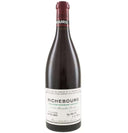Domaine Romanee-Conti Richebourg 2005
Regular price
€4.998,00
Unit price€6.664,00l
Persönliche Beratung durch Weinexperten
Von Alfavin verkostet, geprüft & selektiert
Auch alte Weine im Top Zustand
Gelagert im kühlen feuchten Gewölbe
Only 1 left in stock. Order soon.
Meticulously packed
Fast shipment
Secure, encrypted payment
Chose between Post Nord and UPS delivery

Domaine Romanee-Conti Richebourg 2005
Regular price
€4.998,00


